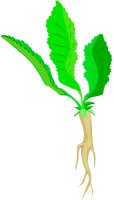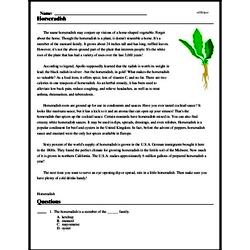Horseradish
National Horseradish Month
Reading Comprehension for July 19
The name horseradish may conjure up visions of a horse-shaped vegetable. Forget about the horse. Though the horseradish is a plant, it doesn't resemble a horse. It's a member of the mustard family. It grows about 24 inches tall and has long, ruffled leaves. However, it's not the above-ground part of the plant that interests people. It's the white root of the plant that has had a variety of uses over the last 3,000 years!
According to legend, Apollo supposedly learned that the radish is worth its weight in lead; the black radish in silver - but the horseradish, in gold! What makes the horseradish so valuable? As a food item, it offers spice, lots of vitamin C, and no fat. There are two calories in one teaspoon of horseradish. As an herbal remedy, it has been used to alleviate low back pain, reduce coughing, and relieve headaches, as well as to treat asthma, rheumatism, and tuberculosis.
Horseradish roots are ground up for use in condiments and sauces. Have you ever tasted cocktail sauce? It looks like marinara sauce, but it has a kick to it and an aroma that can open up your sinuses! That's the horseradish that spices up the cocktail sauce. Certain mustards have horseradish mixed in. You can also find creamy white horseradish sauces. It may be used in dips, spreads, dressings, and even relishes. Horseradish is a popular condiment for beef and oysters in the United Kingdom. In fact, before the advent of peppers, horseradish sauce and mustard were the only hot spices available in Europe.




